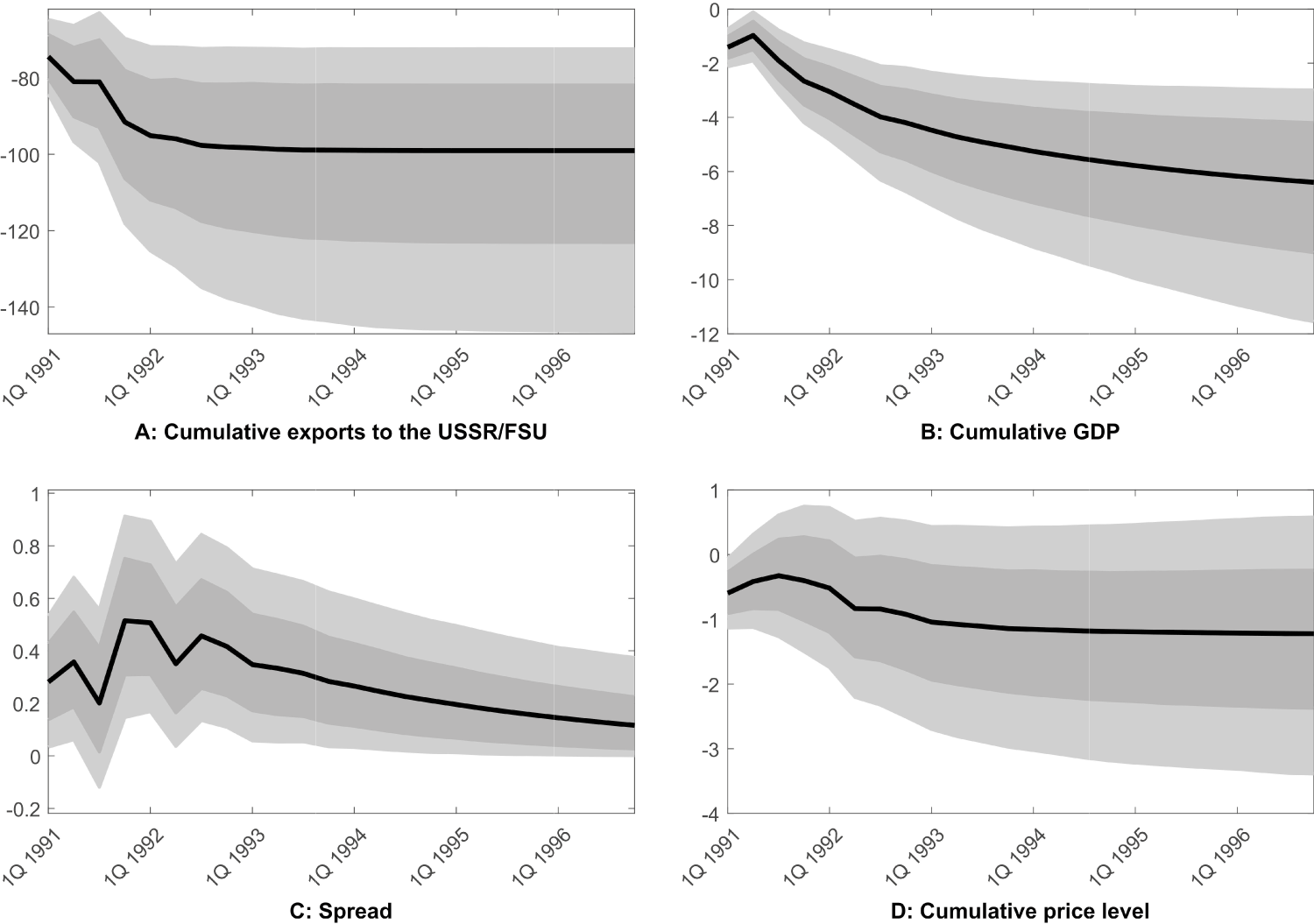What are the economic causes and consequences of large trade disruptions? Are they able to unleash a full-scale economic crisis? In recent years, the news has been full of events such as the US-China trade war, Brexit, and even the collapse of tourism and travel following the outbreak of Covid-19 (Baldwin and Weder di Mauro 2020). Not surprisingly, these discussions revolve in part around the generic macroeconomic problems of identification and endogeneity.
A rare case of a clean trade shock
A unique case of a major trade shock occurred in Finland, a small open economy, in December 1990 when the Soviet Union, its major trading partner, withdrew from a long-held bilateral trade agreement. As a result, Finnish exports to the USSR fell abruptly from 2.4% to 0.8% of GDP in the winter of 1991. The trade collapse happened amid a prolonged economic crisis, still one of the most severe experienced by an industrialised economy since WWII. The cumulative decline in real GDP from its peak in Q3 1989 to the trough in Q2 1993 was 12.1%, a deviation of 17.4% from trend. The pre-crisis level of income was achieved again only in Q4 1996. This was perhaps the only crisis in a post-war developed economy whose origins can be traced back to a disruption in a trading arrangement. The key role of the trade collapse in accounting for the depression in Finland was most prominently stressed by Gorodnichenko et al. (2012).
Figure 1 Finnish GDP, total exports, and exports of goods to the USSR/FSU, 1981-2016
Notes: FSU stands for Former Soviet Union. All series are deflated by the 1995 GDP deflator and expressed as year-on-year growth rates in percent. The vertical line indicates the timing of the Soviet trade collapse. Source: Statistics Finland.
Major trade disruptions, apart from wars (Glick and Taylor 2010), are rare and are blurred with endogeneity considerations. The role of trade during the Great Recession has been analysed by Baldwin (2009) and Born and Enders (2019), for example. Another event studied in more depth was the passing of the Smoot-Hawley Act, which sharply raised US tariffs and triggered a trade war in 1930 (Irwin 1998). In contrast, the collapse in trade between Finland and the USSR in 1991 constitutes a unique historical episode in which a textbook example of a small, open market economy experienced a distinct exogenous shock that is well-identified in time and magnitude. The fact that the shock originated in a relatively isolated country, which the Soviet Union happened to be, only makes the case cleaner. Thus, our case study allows us to shed more light on the importance of trade shocks using an empirical and agnostic approach.1
Finnish-Soviet trade and its demise
Due to its geographical proximity and historical connections, the USSR (and Russia) has traditionally been a major trading partner for Finland. During the Cold War, Finland was also the only developed market economy with a considerable part of its exports (on average 15% in the 1970s and 1980s) directed to the Soviet Union. Finnish exports to the Soviet Union were rather diversified but dominated by wood and paper, ships, machinery and equipment, and textiles to a smaller extent. Finnish imports from the Soviet Union, in contrast, were dominated by crude oil, making the trade effectively a goods-for-oil scheme, largely dependent on fluctuations in global oil prices.
Finnish-Soviet trade was based on a clearing principle and was settled in non-convertible Soviet clearing roubles. The framework was implemented by Soviet-style renewable five-year agreements. Although a renewal deal was signed in October 1989 for the years 1991–1995, the Soviets backed off from it in December 1990, with the desire to switch completely to hard currency trade, to the surprise of Finnish policymakers and entrepreneurs, who regarded the existing trade as highly profitable and had been misled by mixed signals of a multi-year transition period.
The economic aftermath of the cancellation was initially poorly understood but quickly reflected in massive forecast errors by all major Finnish economic institutions, including the central bank. Over the first two quarters of 1991, Finnish exports to the USSR fell by 67%, as shown in Figure 1 around the black vertical line. The collapse was extremely deep for many reasons. Many existing business networks and payment arrangements were suddenly broken, and establishing new ones was very difficult amid the economic and political chaos in the USSR, which ultimately led to the dissolution of the country in December 1991. Furthermore, some goods were tailored specifically to the Soviet market and could not be redirected easily to the West.
How large was the impact of the Finnish-Soviet trade collapse on the Finnish economy? Could it be the main culprit for the Finnish Great Depression of the early 1990s? In a recent paper (Gulan et al. 2021), we re-examine this hypothesis.
How important was the Soviet trade shock?
Our results indicate that the Soviet trade collapse had a considerable negative impact. Figure 2 plots impulse responses of Finnish macro variables following the Soviet trade shock in the first quarter of 1991, recovered from the data using a historical decomposition.
Figure 2 Impulse response reactions to the Soviet shock in Q1 1991
Notes: Responses are cumulative (in percent), except for the spread which is non-cumulative (in percentage points). Units are percent. The black line corresponds to the MLE model. Shaded areas indicate period-wide 66% and 90% impulse responses and capture sample uncertainty.
The shock captures the drop in Soviet demand for Finnish exports as well as the change in Finnish terms of trade. The shock mimics well the actual dynamics. Being a foreign demand shock, it puts downward pressure on the domestic price level and tightens domestic credit conditions, as can be seen from the increasing spread. It also decreases the GDP, which drops by 1.4% on impact. The decline eventually reaches 4.7% in Q2 1993, at which time most of the loss is already realised. When extracting the Soviet shock from the data, we also consider intervals longer than one quarter. This is because the end of the Soviet shock is less clearly defined than its start. Measuring the Soviet shock for two first quarters of 1991, instead of one, changes these figures to 1.6% and 5.9%, respectively. Regardless of the assumed end period of the shock, the results indicate a rather large multiplier of around three. Nevertheless, this accounts for only a fraction of the overall drop in GDP. Based on our analysis, the Soviet shock can explain 27.1% to 33.7% of the cumulative loss in GDP relative to trend, as seen in columns 2 and 3 of Table 1.
We consider a list of factors that may question our results. We explore, among other things, the role of the Soviet Union as a crude oil producer, the fluctuations in global pulp and paper prices (a key Finnish export commodity) as well as the nature of the Finnish labour market. As Table 1 suggests, none of these elements overturns the main result.
Hence, given that the overall loss below trend was 17.4%, the Soviet trade shock could not have been the only major factor behind the Finnish Great Depression. What accounts for the rest of the GDP loss? The results in Table 1 suggest that the most important shocks were of domestic origin, unrelated to the trade shock, with a contribution of -7.4 percentage points. Hence, they account for 42.6% of the total GDP loss.
Table 1 Relative contribution of shocks in total cumulative GDP loss, in percent
Notes: In a given row, the results come from the same MLE-estimated model. Together with all other shocks and initial conditions the rows add up to the total cumulative loss over the depression period (i.e. 100%). Positive signs of shares means the shocks had an overall contractionary impact.
What do these domestic shocks represent? In the mid-1980s, the country went through a process of financial liberalisation that resulted in an explosion of credit, swelling leverage, and soaring asset prices. The financial boom ended with a stock market crash in Q2 1989, over a year before the end of the Soviet trade. What followed was a wave of bankruptcies and a massive crisis in the banking sector (Kiander and Vartia 1996, Vihriälä 1997).
In parallel to the Finnish crisis, Europe was experiencing a monetary contraction, leading ultimately to a recession, the Black Wednesday collapse of the pound sterling in September 1992, and the subsequent Exchange Rate Mechanism (ERM) crisis. According to our results, the impact of European and global shocks is non-negligible, but smaller and more sensitive to specification changes. They mainly reflect the ERM crisis in September 1992. These foreign shocks were large, but they came too late to account for the depth of the depression.
Final thoughts
Finnish exports to Russia experienced large exogenous drops on three other occasions: during the 1998 Russian financial crisis, the 2008 Global Crisis, and in 2014 with the collapse in crude oil prices and retaliatory sanctions that followed Russia's annexation of Crimea. Falling oil revenues also resulted in a significant decline of Soviet imports from Finland in the mid-1980s. None of these events, however, triggered a major contraction in Finnish GDP. This record makes Finnish eastern trade an excellent laboratory for the study of trade shocks and their amplification and propagation. On one hand, it involves a small, open, price-taking economy with negligible sovereign default risk. On the other side is a large trading partner with a relatively volatile economy, buffeted by shocks clearly exogenous to Finland.
To what extent are our results generalisable? Modern trade networks and production chains are more complicated than they were thirty years ago. Finnish firms participating in the Soviet trade were required to have at least 80% domestic input, so production networks were largely domestic. Therefore, first-round and second-round effects were confined to Finland. Today, our results may be more applicable within a wider economic area or a whole production network, rather than to a small open economy with highly connected international production structures (Levchenko et al. 2010).
References
Baldwin, R (2009), The Great Trade Collapse: Causes, Consequences and Prospects, London: CEPR Press.
Baldwin, R and B Weder di Mauro (2020), Economics in the Time of COVID-19, London: CEPR Press.
Born, A and Z Enders (2019), “Global Banking, Trade, and the International Transmission of the Great Recession”, Economic Journal 129(623): 2691–2721.
Glick, R and A M Taylor (2010), “Collateral Damage: Trade Disruption and the Economic Impact of War”, Review of Economics and Statistics 92(1): 102–127.
Gorodnichenko, Y, E G Mendoza and L L Tesar (2012), “The Finnish Great Depression: From Russia with Love”, American Economic Review 102(4): 1619–44.
Gulan, A, M Haavio and J Kilponen (2021), “Can large trade shocks cause crises? The case of the Finnish–Soviet trade collapse”, Journal of International Economics 131(103480).
Irwin, D A (1998), “The Smoot–Hawley Tariff: A Quantitative Assessment”, Review of Economics and Statistics 80(2): 326–334.
Kiander, J and P Vartia (1996), “The great depression of the 1990s in Finland”, Finnish Economic Papers 9(1): 72–88.
Levchenko, A A, L T Lewis and L L Tesar (2010), “The Collapse of International Trade during the 2008–09 Crisis: In Search of the Smoking Gun”, IMF Economic Review 58(2): 214–253.
Vihriälä, V (1997), “Banks and the Finnish Credit Cycle 1986–1995”, Bank of Finland Studies E:7.
Endnotes
1 We work with a vector autoregressive model of a small open economy in which identification is achieved by block-triangular exogeneity restrictions.









